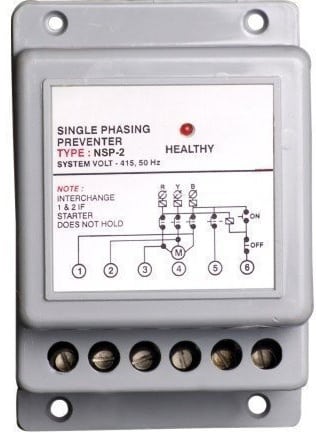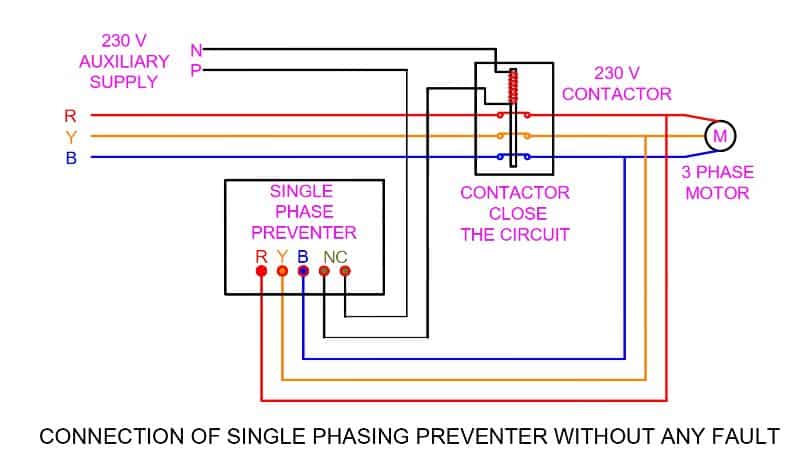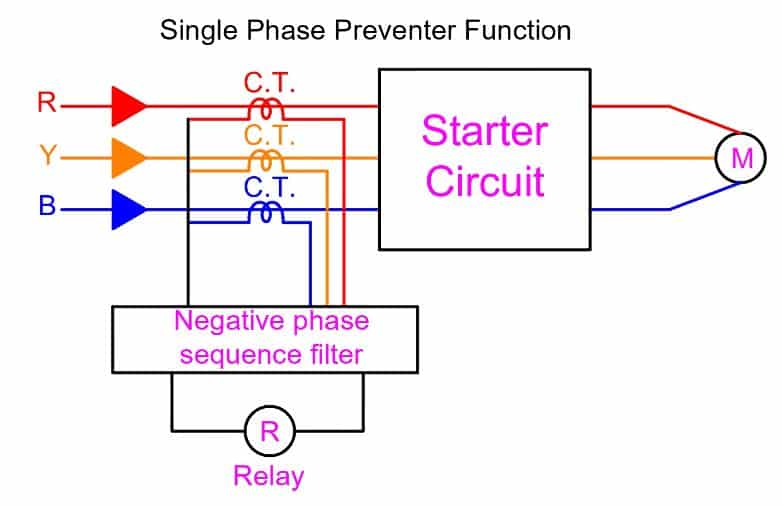In this post, we will learn the single-phase preventer working principle. We use a single-phase preventer to protect the induction motor from a single phasing fault. In the case of the single phasing, the induction motor draws a large current and, the large current may cause failures of the stator winding.
When the motor does not receive the supply of the one of phases is called single phasing. An induction motor is most vulnerable to single phasing. Therefore, there must be some means to protect the motor from single phasing.
The reasons for the single phasing of the induction motor are as follows.
- The one of the phases supply not coming from the supply source
- Single phasing at the main contactor in DOL starter
- The loose connections ultimately lead the loss of connection caused by heating
- Stator winding open
On the occurrence of single phasing, the phase current of the healthy phases reaches up to 3 times of normal running current. The increased current causes heating and, eventually, causes motor failure.
Single phasing causes unbalance in phase current. The unbalance current is the negative phase sequence current. The negative phase sequence current produces negative torque, and thus the net torque reduces. The reduction in the motor torque may cause motor stalling. The motor trips with an over-current fault or stall protection fault. But, during a single phasing period, the motor experiences heavy electrical and mechanical stress. In this case, a single-phase preventer relay is the best choice.
Therefore, a Single phase preventer relay is necessary for motor tripping to avoid unnecessary stress on the motor. The single-phase preventer trips the motor immediately when single phasing occurs.
Single Phase Preventer Relay

The single-phase preventer relay is the protective relay that detects the phase failure and trips the motor immediately on the occurrence of single phasing.
Types
The single-phase preventer relay functions on the principle of sensing the voltage and sensing the current of the three-phase supply system. We can classify the relay as;
- Voltage sensing Relay
- Current Sensing Relay
Voltage Sensing Single Phase Preventer
The voltage sensing relay continuously monitors the three-phase supply voltage. The auxiliary contact of the relay remains NC when the three-phase supply is healthy.

The contact of the relay changeover from NC to NO in the case of even failure of one of the phases.
Current Sensing Single Phase Preventer
Current sensing single phase preventer measures the current of three-phase supply going to the induction motor. The relay basically measures the negative sequence current of the motor. Under the current unbalance condition, the magnitude of negative phase sequence current increases, and relay trips the main contactor.

The current transformer is placed in each phase to monitor the phase current. The current transformer output first goes in the filter circuit that separates the negative phase sequence current. The relay then measures the magnitude of the negative phase sequence current.
The control circuit of the relay receives current magnitude from the filter circuit and outputs the trip command to the contactor/ circuit breaker if the magnitude of the negative sequence current is more than the preset value.
Read Next :